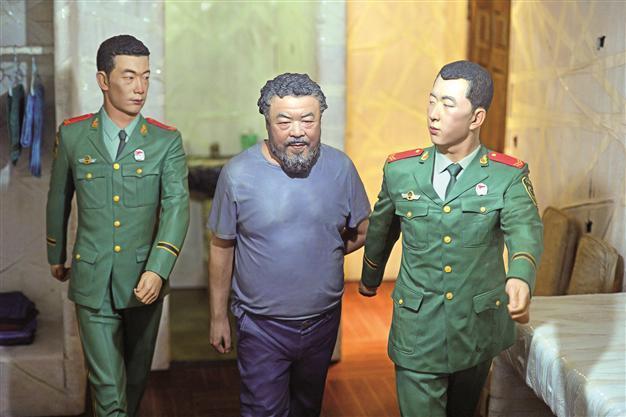Turkish pavilion reflects on “Obstructions”
ISTANBUL- Hürriyet Daily News

Ai Wei Wei’s work that reflects his prisonment in China becomes on of the most important work in biennial.
The 55th International Art Exhibition “La Biennale di Venezia” opened on June 1. This year the rich diversity of unexpected sights and sounds at the world’s largest non-commercial art exhibition is partly a result of sheer numbers, with shows from 88 countries installed across the canal city in time for this week’s opening.
More than 150 artists are taking part in the Biennale, which has been running since 1895 and continues to attract artists, art-lovers and collectors from across the world to Venice. The biennial will last until November 24.
This year the Pavilion of Turkey presents Ali Kazma’s new video series “Resistance,” from June 1 to November 24, 2013. Curated by Emre Baykal, the Pavilion of Turkey is located at Artiglierie, Arsenale, one of the main venues of the biennale.
Ali Kazma’s multi-channel video installation “Resistance” explores the interventions and strategies that both release the body from its own restrictions and restrict it in order to control it. As an extensive survey on the contemporary discourses, techniques and management tactics developed for the human body, “Resistance” is an attempt to unravel the interventions imposed and practiced on the body today.
“Resistance” evolved out of “Obstructions,” another series Ali Kazma began to produce in 2005 to explore the ways in which the body is shaped today through scientific, cultural and social tools, and how, as a performance site, it is repeatedly reproduced. In other words, “Resistance” conveys the productive activity of the body as a creative force directly onto the body itself: the producer and the produced, the shaper and the shaped are united in the materiality of the body.
During the almost one-year long filming process of “Resistance”, Ali Kazma visited various sites to record the processes that both construct and control the body. He contemplates the human being’s struggle to break the social, cultural, physical and genetic codes of the human body, as well as the processes during which the body is transformed into a conveyor of new symbols and meanings.
In this comprehensive project, Ali Kazma worked in various parts of the world in different settings and with different subjects; a film set in Paris, a prison in Sakarya, a school and a hospital operating room in Istanbul, a cryonics institution in the US, a neurorobotics research laboratory at a university in Berlin, a medical research laboratory in Lausanne, and a tattoo studio in London, to name just a few.
The book that accompanies Ali Kazma’s video installation “Resistance,” is published by İKSV and Yapı Kredi Publications, and designed by Esen Karol who has also designed the communication material of the project. The bilingual book will be launched during the opening of the pavilion and subsequently sold in major bookstores.
Capturing the world
“Every two years we try to capture the world – and then the world is unruly,” Biennale curator Massimiliano Gioni told Reuters.
Ten countries, including the Vatican and the Bahamas, are participating for the first time this year with their own dedicated pavilions in a fair that runs until November.
“The national pavilions are fantastic because they give us a glimpse of the diversity of the world... a world of exceptions,” said Gioni.
The Holy See’s pavilion, in the Arsenale or old shipyard site, is a far cry from the Renaissance masterpieces of the Vatican.
Ai Weiwei shocks in Venice with scenes of prison life.
According to AFP, Chinese dissident artist Ai Weiwei tells the story of his 2011 incarceration with an installation of six large rusty metal boxes in the nave of a Venetian church at the Biennale art festival.
In the Baroque surroundings of St Antonino – a short walk from St Mark’s Square – the unusual display encourages visitors to peer inside the mysterious boxes to see what might be inside.
Like a twisted doll house turned into a Chinese prison, the sculptures are scenes from his detention with the artist shown going about his daily tasks with two guards present all the time.
In one he is sleeping as guards watch, then he is naked in the shower, pacing in his cell, eating a meal, talking and going to the toilet.
SUPPORTING ISTANBUL FROM VENICE BIENNALE
ISTANBUL – Hürriyet Daily News
On June 1, artists, curators from Istanbul gathered at St Mark’s Square to protest in solidarity with the Gezi Park events during the Venice Biennial. The protesters held placards in their hands with messages of support for Istanbul and the Gezi Park protestors. While the Venice Biennial was going on, the protesters of Gezi Park gathered to support Istanbul and people who have been staying in Taksim for four days at Gezi Park. Clashes broke out on May 31, as police had staged a crackdown after blocking the arterial roads connecting to Taksim. Amnesty International has called on the authorities to immediately halt the brutal police repression of protests triggered by the demolition of Gezi Park.
